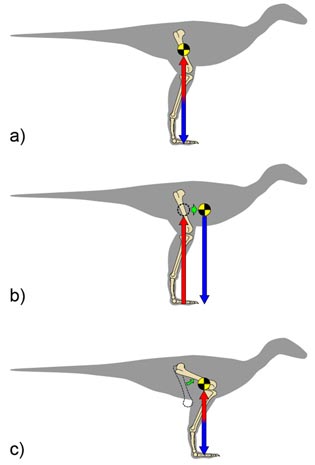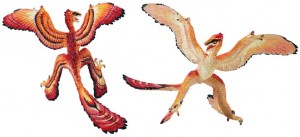Birds have the Dinosauria to Thank for Their “Crouching Gait” According to New Research
How Changing Body Shape Affected Balance and Posture During the Evolution of the Dinosauria and Aves
The bipedal birds with their crouching gait have the dinosaurs to thank for their posture. The birds, descendants from a group of theropod dinosaurs, have a very different solution to standing on just two legs than our species H. sapiens. Humans and birds, (birds are sometimes referred to as avian dinosaurs), may both be bipedal but their legs are held in very different stances, giving them different gaits and postures. Humans have their leg bones held straight underneath their hips, an efficient method of supporting body weight. Our legs are straight and directly underneath us, a bit like a column in a building being straight and positioned directly under the roof that it is holding up.
Bird Legs
Bird legs are bent into a “z” shape with the femur (thigh bone) being held in a much more horizontal position. Birds have adopted a “crouched standing position”, one that takes more energy and is less efficient that our own stance. The crouched position requires more muscular effort in order to permit the organism to remain upright and balanced.
Birds and humans walk differently, birds have a digitgrade stance (walk on their toes, walking on their digits), a method of locomotion seen in theropod dinosaurs, even the likes of Tyrannosaurus rex. Human beings on the other hand (no pun intended), and their ancestors, adopted a different method of walking – plantigrade. Organisms that adopt a plantigrade stance walk on their toes but their body weight is supported by the vast majority of the foot (or hand), for example bears have a plantigrade stance. We have a plantigrade stance, we walk on our toes but also our heels.
New Dinosaur Research
New research published this week in the journal “Nature” shows that the conventional view of how birds got their crouching stance, a result of tails becoming lighter and shorter may not be entirely accurate. Evidence is presented that suggests that body shape changed during archosaur evolution and this had serious consequences for the archosaurs, the dinosaurs and eventually those descendants of the dinosaurs, the birds.
This study, a collaboration between a number of scientists including leading researchers from the Royal Veterinary College (London), proposes that it was the enlargement of the forelimbs, rather than the shortening and the lightening of the tail that led to bipedal dinosaurs gradually adopting a crouched posture, with the thigh bone (femur) held in an almost horizontal position. This characteristic associated with the bipedal Eumaniraptora was to be inherited by their descendants the Aves (birds).
Bird Posture Inherited From Dinosaurs

Figure 1: Animal standing or at the midpoint of a step (a). For the animal to balance, forces applied by the feet (red) must match the force of body weight (blue) pointing downwards from the centre of mass (yellow/black). If the centre of mass moves forward (b), then the feet must move forward (and thus the limb must get more crouched) to maintain balance, as in (c).
Picture credit: Royal Veterinary College
The Posture of Dinosaurs
Dr Vivian Allen and Professor John R. Hutchinson of the Royal Veterinary College led the research which essentially consisted of creating extremely detailed computer models of skeletons of seventeen types of Archosaur, then adding digitally flesh and muscles to assemble the whole creature. Sort of building up an animal from the bones outwards. This allowed the scientists to see how body proportions changed as the Archosauria evolved.
The University of Liverpool’s Dr Karl Bates and researcher Zhiheng Li, who at the time was based at the famous Institute for Vertebrate Palaeontology and Palaeoanthropology (Beijing, China) were also part of the research team.
Dr Allen explained that the researchers created complex computerised three dimensional images of the species in the study. Detailed reconstructions was possible using analysis of the fossilised bones as well as computerised tomography (CT scans) of extant relatives.
Studying Archosaurs
Earlier research papers had proposed that the archosaurs in the Early Triassic were anatomically very similar to modern crocodilians with long, heavy tails and a sprawling or semi-erect gait. However, early in the evolution of the Dinosauria, perhaps as a result of the archosaurs diversifying to take advantage of gaps in food chains as a result of the Permian mass extinction, the Dinosauria seem to have become bipedal. From these fast, cursorial bipeds the Dinosauria evolved, first the saurischian (lizard-hipped) and later the ornithischian (bird-hipped) forms.
The anatomical characteristics associated with a bipedal stance and gait were inherited by the dinosaurs descendants the birds. Prehistoric creatures studied in this research include the famous Archaeopteryx (Upper Jurassic strata of Germany), Microraptor a feathered, flying dinosaur from Lower Cretaceous China and Velociraptor from Upper Cretaceous fossil bearing sediments.
Microraptor’s Wings Suggest a Link to Bird Stance and Posture
Picture credit: Everything Dinosaur
The picture (above) shows model dinosaurs from the Wild Safari Dinos range.
To view this range of prehistoric animal figures: Safari Ltd Dinosaur Models and Figures.
It had been thought that the relatively strange way of locomotion for birds and their stance had evolved gradually as the tails of their ancestors become shorter and lighter. Extant birds do not have a tail as such, but compressed highly reduced bones (the last five caudal vertebrae that make up the pygostyle. As the tail got shorter and less heavy, the centre of mass of the organism was slowly shifted forward. As certain dinosaurs became more avian, the legs needed to become less vertical and more crouched with a near horizontal femur to keep the centre of mass balanced over the feet.
Change in Stance and Body Position
This change in stance and body position, may hot have been driven by tail shortening. The enlargement of the forelimbs in the Dinosauria could have been the catalyst. Birds that fly have enlarged front limbs that form wings, dinosaurs did not evolve large forelimbs for flight, this may have just been an indirect consequence of the need to evolve larger forelimbs to chase and grasp prey.
Professor Hutchinson stated:
“We’d never doubted the hypothesis that the tail was responsible for the major changes in dinosaur balance and posture. The tail is the most obvious change if you look at dinosaur bodies. But as we analysed, and re-analysed, and scrutinised our data, we gradually realised that everyone had forgotten to check what influence the forelimbs had on balance and posture, and that this influence was greater than that of the tail or other parts of the body.”
The Centre of Mass
With an aim of trying to determine when and how the centre of mass changed its position in the Dinosauria, modern computer-based techniques were used to assess the timing of the change in stance as recorded by fossil material preserved in the fossil record. When this change may have occurred remains controversial. Was the change in body position and stance gradual, or was it relatively swift as the first birds evolved powered flight?
The British based researchers in collaboration with their Chinese counterparts found evidence to support both scenarios. There were gradual changes in the fossil specimens associated with the early dinosaurs and more sudden changes associated with the first birds and just before flight may have evolved.
An implication for this research is that due to the effects on the central mass position on leg posture, the size of the forelimbs and leg function are linked bio-mechanically. As forelimbs got larger, this altered the way the dinosaurs and their descendants stood walked and ran.
Intriguingly some super-heavy weight theropods such as the tyrannnosaurids and the abelisaurs had very much fore-shortened front-limbs. The three-dimensional computer models in conjunction with other aspects of this research could shed light on the reasons why these large predators evolved such short arms.


